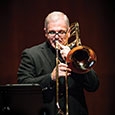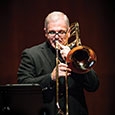Primary and Alternate Positions
In my most recent article for The Instrumentalist (Understanding Brass Instruments, June 2020), I explained how the harmonic series is the key to understanding how brass instruments work. I used as my example a simple chart showing the first eight partials in each of the seven slide positions on a tenor trombone without using the F-attachment. (below)
There, my point was that the intervals between partials are the same in each position, as are the tuning tendencies of each partial, and that this pattern holds for all brass instruments. The harmonic series, then, becomes a tool for finding alternate fingerings or positions for various purposes. For now, I want to focus on something else: the favored slide position for a given note is almost always the one closest to first position. This is because the closer you are to first position, the shorter the instrument is, and the greater the proportion of conical tubing compared to cylindrical. When the slide is extended or valves engaged, the instrument has greater resistance both because of the longer tube and the greater proportion of cylindrical tubing. The slide and valve tubing maintain a constant diameter, while the bell and main tuning slide have conical tubing that expands and thus has greater area within. A less resistant instrument will more easily facilitate the production of a full and resonant sound, thus the usual preference for positions closer to first.
The only exception to this in the notes pictured below is Ab4, which is so flat in first position that it is unusable there, and thus the next available position, third, is preferred. (The remaining notes in the seventh partial can be played on trombone using a significant slide position adjustment; that entire partial is normally unusable on valved brass instruments.)
While these shorter positions are the primary positions for each note, players will often use alternate positions for a variety of reasons. These can be grouped into the following four categories.

Improved Mechanics
The most obvious reason for using alternate positions is greater technical ease by reducing the number of long slide movements and changes of direction needed. An easy place to introduce this concept is the tune Jingle Bells in the key of Bb, which is found in many beginning band methods.

While advanced players will not always use an alternate position in a slower passage like the eighth bar here, in other respects this is a great candidate for alternate position use. Remaining in sixth position for the F3 eliminates the long motion from sixth position back to first, as well as the immediate change of direction required to go back to fourth position for the next note. That this is a familiar tune and an easy passage makes this ideal for introducing of alternate positions and a key reason for their use.
Of course, advanced trombonists use alternate positions for mechanical advantage to great effect in difficult technical passages. The trombone showpieces of Arthur Pryor (1870-1942) supply numerous examples of this, including the following cadenza from Fantastic Polka.
In this cadenza (see example below), using alternate positions while moving through the series of diminished seventh chords eliminates excess motion. particularly shifts in direction, while creating a repetitive slide pattern that is comparatively easy to execute, although some tuning adjustments are needed. This enables a skilled player to increase speed while maintaining a fluid motion, creating greater ease of mechanical execution and improved articulation.
Arthur Pryor, Fantastic Polka Cadenza

Timbral Consistency
The remaining reasons for using alternate positions are perhaps less obvious than increasing mechanical ease but should nevertheless factor into a player’s position choices. First, consider timbre. As already indicated, the position closest to first for a given note ordinarily yields the fullest sound. However, there are instances where a lighter sound is desirable, and this is most easily achieved in an outer position. For example, in keys like Gb major and B/Cb major, the leading tone (F and A#/Bb, respectively) can be played in first position, but the tonic is in an outer position. Here, choosing an alternate position that keeps the leading tone and the tonic in the same partial lends consistency of sound while also preventing the leading tone from overwhelming the tonic due to its fuller sound in first position. Consider this example from the Trombone Concerto by Nicolai Rimsky-Korsakov (1844-1908), where leading tone-tonic relationships (or similar relationships) like this abound in just a few bars:
Rimsky-Korsakov Trombone Concerto, 2nd mvt.

The places where players can use alternate positions are marked above the notes. Except for the first F3 in the penultimate bar, the alternate position provides an obvious mechanical advantage in addition to considerations of timbre. However, most students will play all of the indicated notes in first position if not instructed otherwise. To my ear, the timbral considerations are even more important here, as moving back to first position for these notes gives them a certain weight that is inappropriate and also introduces an articulation issue. These alternate positions yield a consistency of timbre that is particularly becoming in addition to the greater technical ease.
Tuning Adjustments
The handslide theoretically facilitates accurate intonation on every note in nearly every available position, but the trombone also has the same tuning tendencies of the various partials as every other brass instrument. Choosing positions that make these tendencies serve musical purposes makes playing much easier. For example, while D4 is ordinarily played in first position, fourth position is a common alternate that often yields greater mechanical efficiency but also tends to be a bit sharp relative to the first position note. In a chord where that note needs to be raised – G major, for example – playing D4 in fourth position can help to lock in the tuning by taking advantage of the tuning tendency that already exists.
Such possibilities are even more numerous and perhaps more helpful the upper register. C5 is most often played in either first or third position, and it tends to be slightly sharp in the former and slightly flat in the latter. Playing in first position might help one to properly tune an F major triad, where the C needs to be raised, while in Ab major, where it needs to be lowered, third position might be most helpful. Because the upper register partials are so close together, position choices have less impact on mechanical ease than in the lower part of the range, where outer positions are more common. Instead, tuning becomes a primary consideration, as does timbre.
Improved Articulation
Regarding articulation, trombonists are commonly taught to consider alternate positions in legato passages where alternate positions will cause the player to cross partials in the overtone series or engage a valve, thus creating opportunities for natural slurring without use of the legato tongue. That advice is wise and often helpful. For example, in the passage below from the Trombone Concerto by Gordon Jacob (1895-1984), playing the Bb3 in the sixth bar in fifth position, while yielding no obvious technical advantage (it merely delays a large slide movement by less than one beat), allows the player to maintain consistency of articulation throughout the passage. The player will use natural slurs for all of the indicated slurs instead of introducing the legato tongue as would be necessary to play this note in first position. Playing the C3 in the next bar using the F-attachment in first position has a similar effect; most players will do this intuitively. Besides creating more consistency of articulation, using natural slurs throughout this passage makes the rapid tonguing required for the remaining notes just a bit easier.
Jacob Trombone Concerto, 1st mvt.

It is worth noting that sometimes the smoothest articulation is achieved when one eschews a natural slurring opportunity requiring a very long slide movement in favor of using the legato tongue in combination with a shorter slide movement. Consider the above Rimsky-Korsakov excerpt again. Playing the Bb3 in the eighth bar in first position permits using a natural slur, but the long slide movement might negate the advantage of the natural slur by jostling the instrument in a way that creates an articulation of its own, in addition to creating a timbre issue. Although this effect is largely mitigated when the slide is in good repair and one has efficient slide technique, shorter motions with fewer changes in direction combined with good tonguing technique (particularly a good legato tongue) often facilitate the best articulation.
While trombonists most often use alternate positions for mechanical ease, timbre, tuning, and articulation should also factor into slide position choices. As the above excerpts exemplify, these considerations often overlap, thus making these choices quite easy for attentive players. Trombone students should develop the fullest possible understanding of the overtone series and the alternate position opportunities that exist, and then use these to make playing easier and the sound more beautiful.






